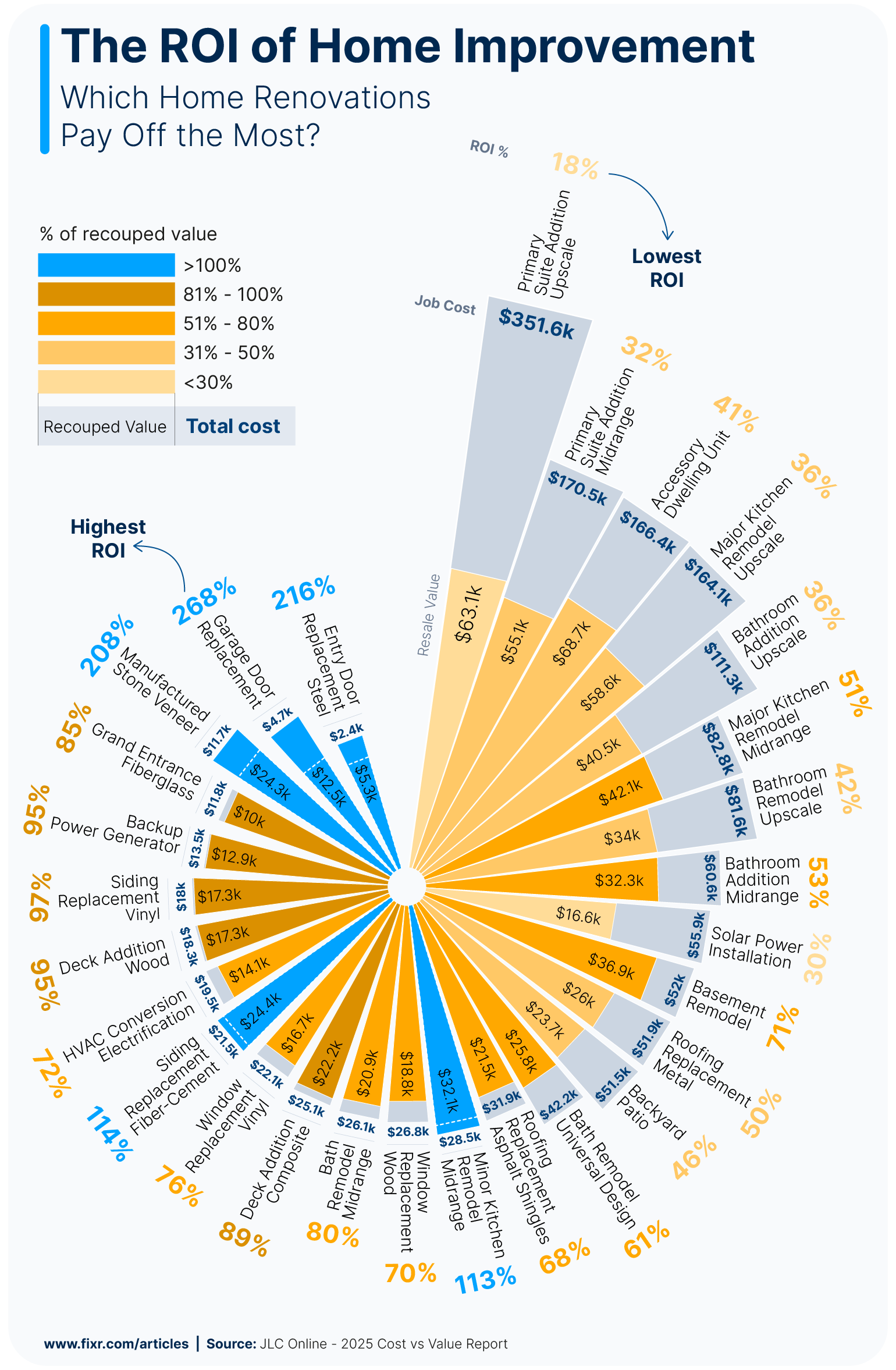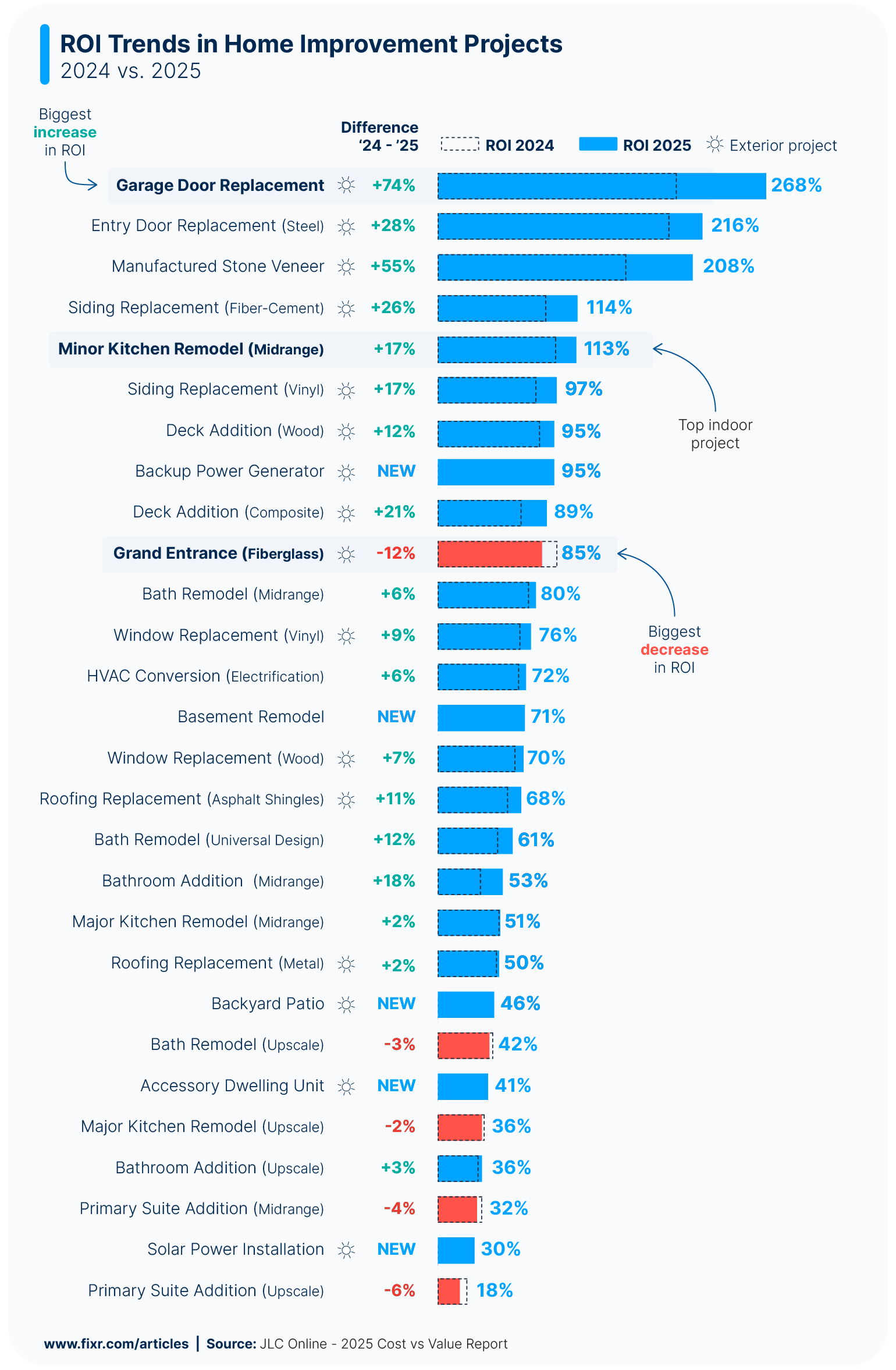Why Does Home Remodeling ROI Matter?
Homeowners undertake improvement projects for two main reasons: to enhance their comfort or to boost their home's resale value. Comparing the cost versus value of projects helps you, the homeowner, decide whether a project will increase your home’s sale price enough to justify the expense.
Return on investment (ROI) is a metric used to evaluate a project's profitability. It's calculated by quantifying the added value a remodeling project contributes to a home and dividing it by the total expenses incurred. The simple answer to "which project is worth it?" is the one with the highest ROI.
Considering the ROI of remodeling projects is essential to understanding the value they can add to the home upon resale. According to Zonda’s JLC Cost vs Value report, a garage door replacement brings the highest ROI in 2025, with 268% of its costs recouped at the sale. That's up 74.1% over last year's report.
Many changes have occurred since last year's report. When homeowners stay aware of current trends and cost data, they can make wise choices when embarking on a home remodeling project. Let's dive in and discover what's new for 2025.
The ROI of Home Remodeling Projects in 2025
With so many options available, it can be hard to know which projects truly make a difference when it comes to resale value. The chart below highlights how popular home improvements perform in 2025, offering a clear snapshot of which upgrades get the highest return on investment.

Comparing ROI Trends in Home Improvement Projects: 2024 vs. 2025
We’ve created a cost vs value chart to highlight the remodeling projects with the highest ROI in 2025 and how their returns have changed compared to 2024. Of the 28 projects analyzed for this year's Cost vs Value report, several showed remarkable growth in ROI.

The project with the largest gain was Garage Door Replacement, which increased from 194% to 268% ROI, a 74.1% jump from 2024.
Other Top-Gaining Projects:
Manufactured Stone Veneer: +54.8% (207.9% ROI)
Entry Door Replacement (Steel): +27.9% (216.4% ROI)
Fiber-Cement Siding Replacement: +25.6% (113.7% ROI)
In total, 19 of the 28 projects improved in ROI compared to last year, reflecting a continued strong market focus on essential, impactful upgrades.
ROI varies widely across different U.S. markets, depending on regional housing trends, material costs, and buyer preferences.
Curb Appeal Projects Lead in ROI Growth
The highest gains remain concentrated among front-of-house, exterior replacement projects. Garage door replacement, entry door replacement, and manufactured stone veneer not only had the best returns on investment this year but also experienced the most significant increases since 2024.
This reinforces the long-standing importance of curb appeal in influencing a potential buyer’s perception. According to real estate expert Paige Robinson, owner of House Buyers, “Curb appeal projects often outperform indoor projects in ROI because they directly impact a potential buyer's first impression of a home.”
Other exterior projects with notable gains:
Wood Deck Addition: +12.1% (94.9% ROI)
Composite Deck Addition: +20.8% (88.5% ROI)
Siding Replacement (Fiber-Cement): +25.6% (113.7% ROI)
These figures highlight that investing in visually impactful upgrades at a reasonable cost continues to deliver high value.
Interior Projects With Consistent Strong Performance
Among interior projects, the minor kitchen remodel remains the standout, returning a 113% ROI (+17%), up from 96.1% in 2024. This positions it as the leading indoor project for value recovery.
Why does the minor kitchen remodel win? This upgrade typically involves refreshing cabinets, replacing countertops, and upgrading appliances without changing the room's footprint. According to Brian Mollo, CEO of Trusted House Buyers, “Because the kitchen is the most important room on the radar of home buyers, a cost-effective upgrade will net you the biggest return when you list your home for sale.”
Similarly, a midrange bath remodel delivers a strong 80% ROI (+6%), while a universal design bathroom remodel returns 61% ROI (+12%). Adding to this category's strong performance, a midrange bathroom addition saw an excellent gain of +18% for a 2025 ROI of 53%, appealing to buyers who value increased functionality and square footage. These interior projects, focused on function and cost-effectiveness, make them consistent, moderate investments.
Projects with Declining ROI
Not every project saw a gain in 2025. The biggest ROI decrease this year came from the grand entrance (fiberglass), which decreased by 12.4%.
Other projects with notable declines:
Primary Suite Additions (Upscale): -5.9%
Primary Suite Additions (Midrange): -3.5%
Upscale Bath Remodels: -3.1%
Major Kitchen Remodels (Upscale): -2.0%
This year, homeowners face new cost pressures from tariffs imposed by the Trump administration in 2025 on imported kitchen cabinets, bathroom vanities, and associated products. These tariffs are pushing up overall remodeling costs, particularly for kitchens and bathrooms. As a result, even projects with strong ROI potential may see reduced returns unless homeowners carefully manage material choices and project scope.
Emerging Projects Reflecting New Homeowner Priorities
Several new projects appeared in this year’s report, including essential resilience and lifestyle upgrades:
Backup Power Generators: 95.3% ROI.
This high return signals strong market interest, particularly in regions prone to severe weather and outages, as buyers prioritize safety and energy resilience.Basement Remodels: 71% ROI.
Converting unused basement space into livable, functional square footage, like a home office or gym, can greatly enhance the home's utility and appeal.Backyard Patios: 46% ROI.
Underscores the continued buyer demand for high-quality, functional outdoor living spaces. A well-designed patio is seen as an affordable way to extend the home's usable footprint without the cost of a full addition.Accessory Dwelling Units (ADUs): 41% ROI
While costs are high, ADUs reflect a growing trend for multi-generational living, supplemental rental income, and adding flexible space. The value added is often realized not just at resale but through immediate rental cash flow.Solar Power Installations: 30% ROI.
Reflects a growing priority for sustainable and cost-saving energy upgrades. Buyers are increasingly willing to pay a premium for homes that come with lower utility bills and an established commitment to sustainability.
While these projects show lower ROI relative to the high-performing curb appeal upgrades, they reflect growing homeowner priorities such as energy resilience, additional living space, and sustainable upgrades.
Understanding the True Cost vs Value of Home Remodeling Projects
The cost of home remodeling projects largely depends on factors such as location, trends, and labor and material costs. Then, the amount recouped from a project hinges on the state of the real estate market at the time of resale. Due to these ever-changing factors, the Cost vs Value report reveals fluctuating ROIs each year.
Is a more expensive project always better? No. A more expensive project doesn't necessarily bring the greatest return on resale. For instance, in this year's report, affordable projects like garage and entry door replacements have the highest ROIs. On the other hand, a bathroom remodel is a costly project that brings a lower ROI than other jobs. However, while higher-cost projects generally add more value to a property, homeowners should not expect to recoup a large portion of the investment upon resale.
FAQ
Cost vs value is a way to evaluate home improvement projects by comparing how much money you spend on a project with how much of that cost you can expect to recover when you sell your home.
Cost refers to the actual amount of money spent on a project, including labor, materials, and any other associated expenses. Value represents the estimated financial benefit you gain from completing that project. While cost is certain and immediate, value is a projection based on market trends, buyer preferences, and regional factors.
Cost and value are project-specific terms, focusing on individual improvements and their impact on resale. Valuation, in contrast, is a comprehensive assessment of your home’s overall market worth. It considers factors like location, size, condition, and comparable properties, giving a full picture of what your home could sell for, not just the return on a single project.
The cost vs value model is a tool, often presented in annual reports by real estate and remodeling experts, that helps homeowners understand which projects deliver the best ROI. By comparing project costs with their expected resale value, this model allows homeowners to prioritize home renovations that are likely to increase the value of their home while avoiding projects that may be less financially beneficial.
Methodology
To assess trends in home remodeling ROI, we analyzed the JLC Cost vs Value reports for 2024 and 2025. We compared each project’s ROI across the two years and calculated the percentage change from 2024 to 2025 to identify projects with the largest gains or declines in value.
Irena is an industry analyst and financial content specialist at Fixr.com, where she transforms complex housing and economic data into clear insights that help homeowners make smarter financial decisions. She holds a degree in Economics and has been conducting personal finance research since 2018, bringing a strong analytical foundation to her work. Her insights have been featured in reputable outlets such as the Washington Examiner, Yahoo Finance, Fox40, and Forbes.
